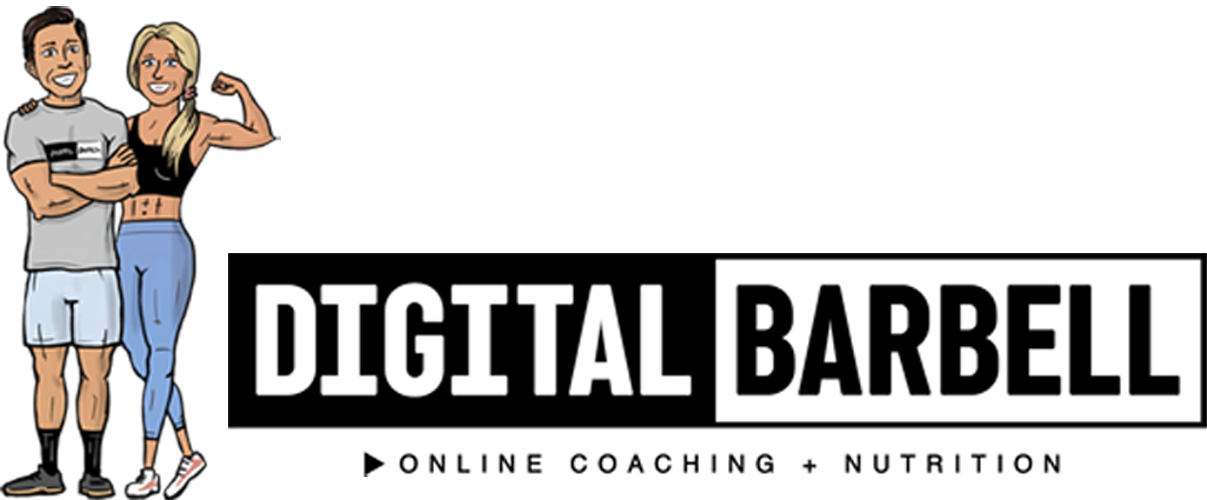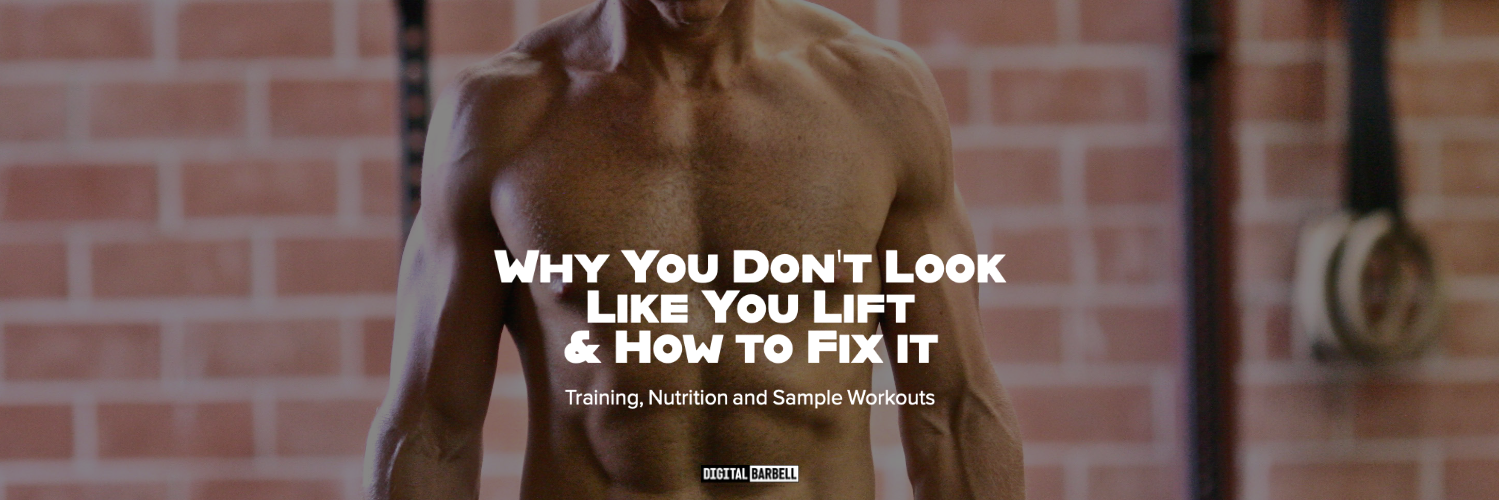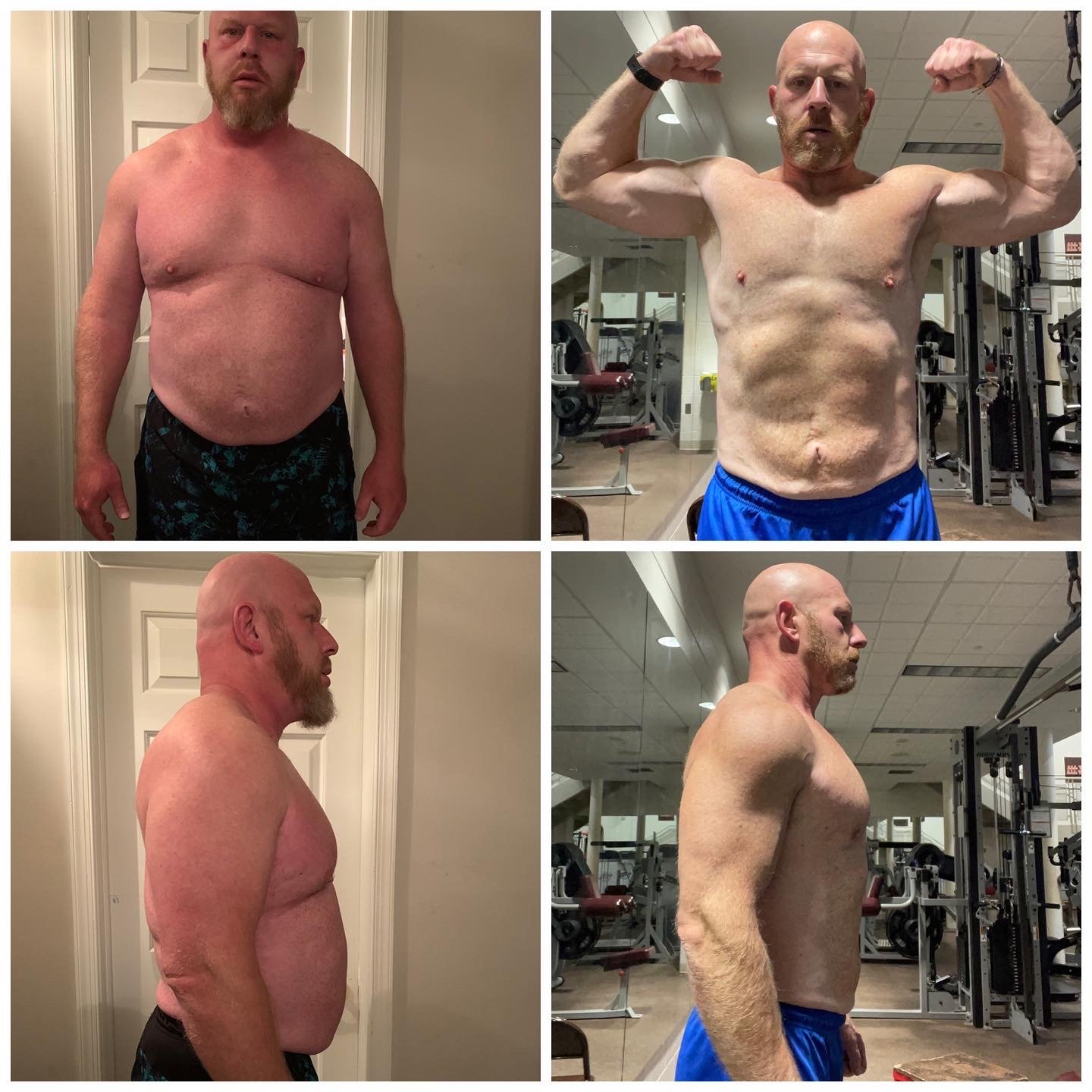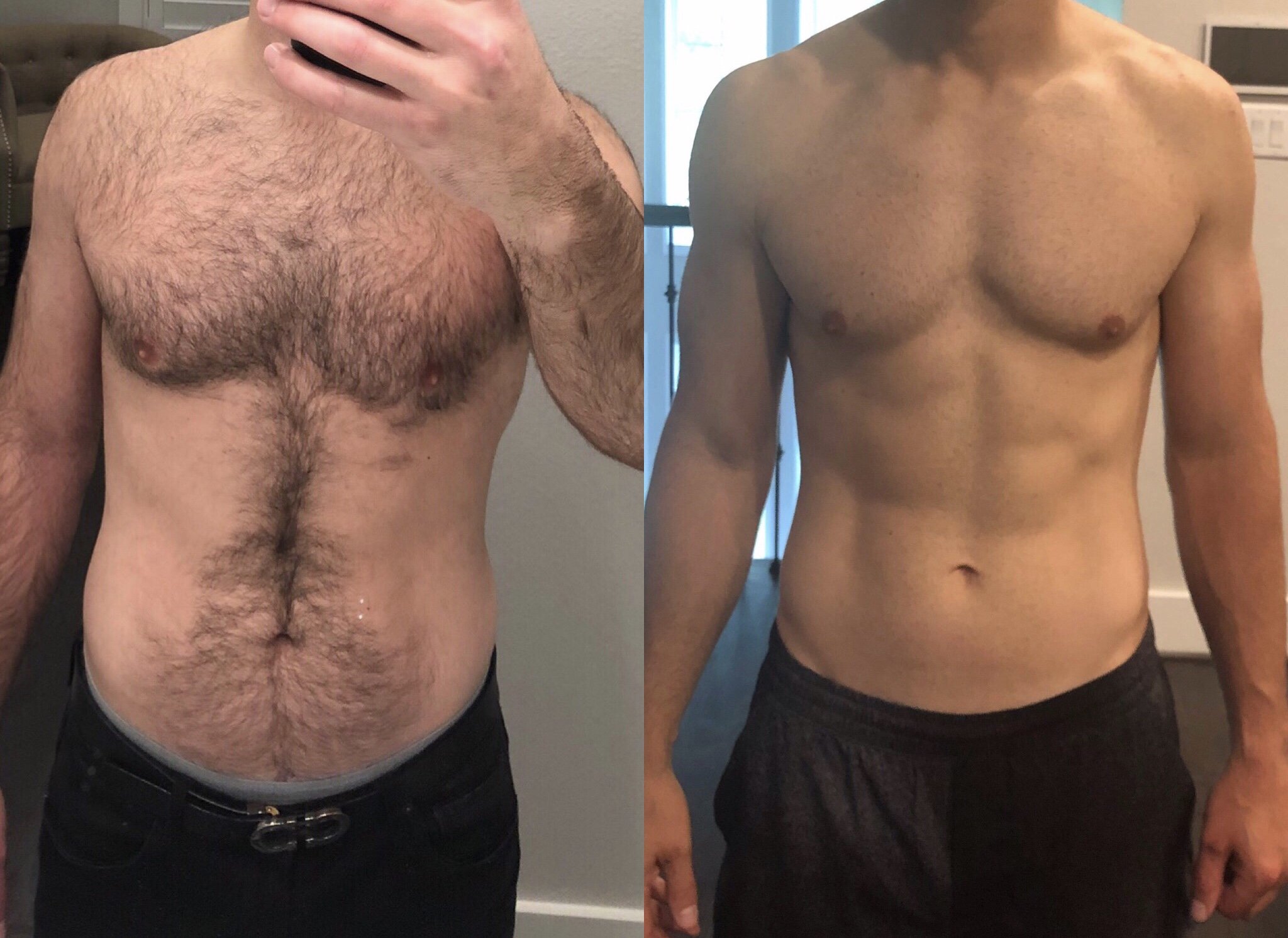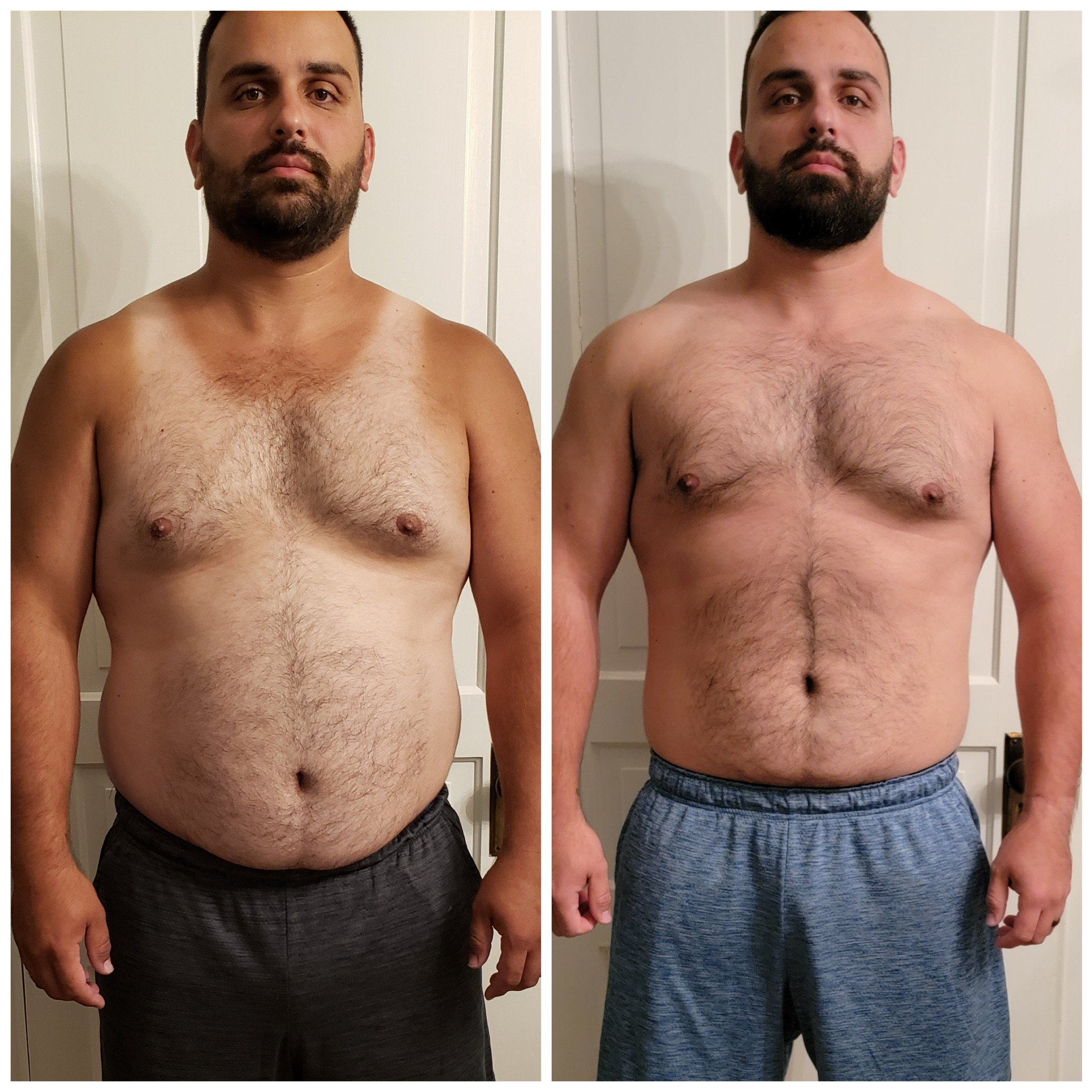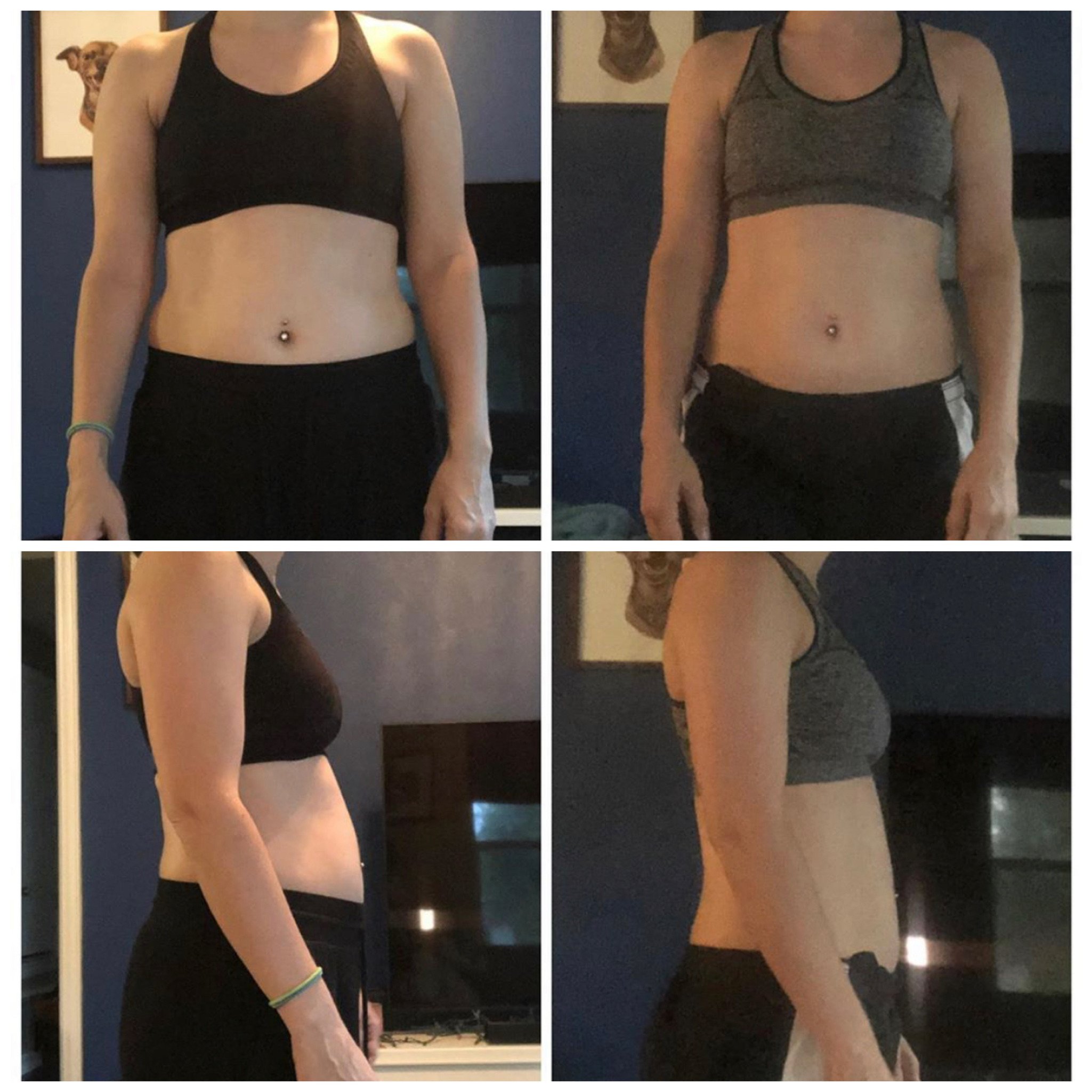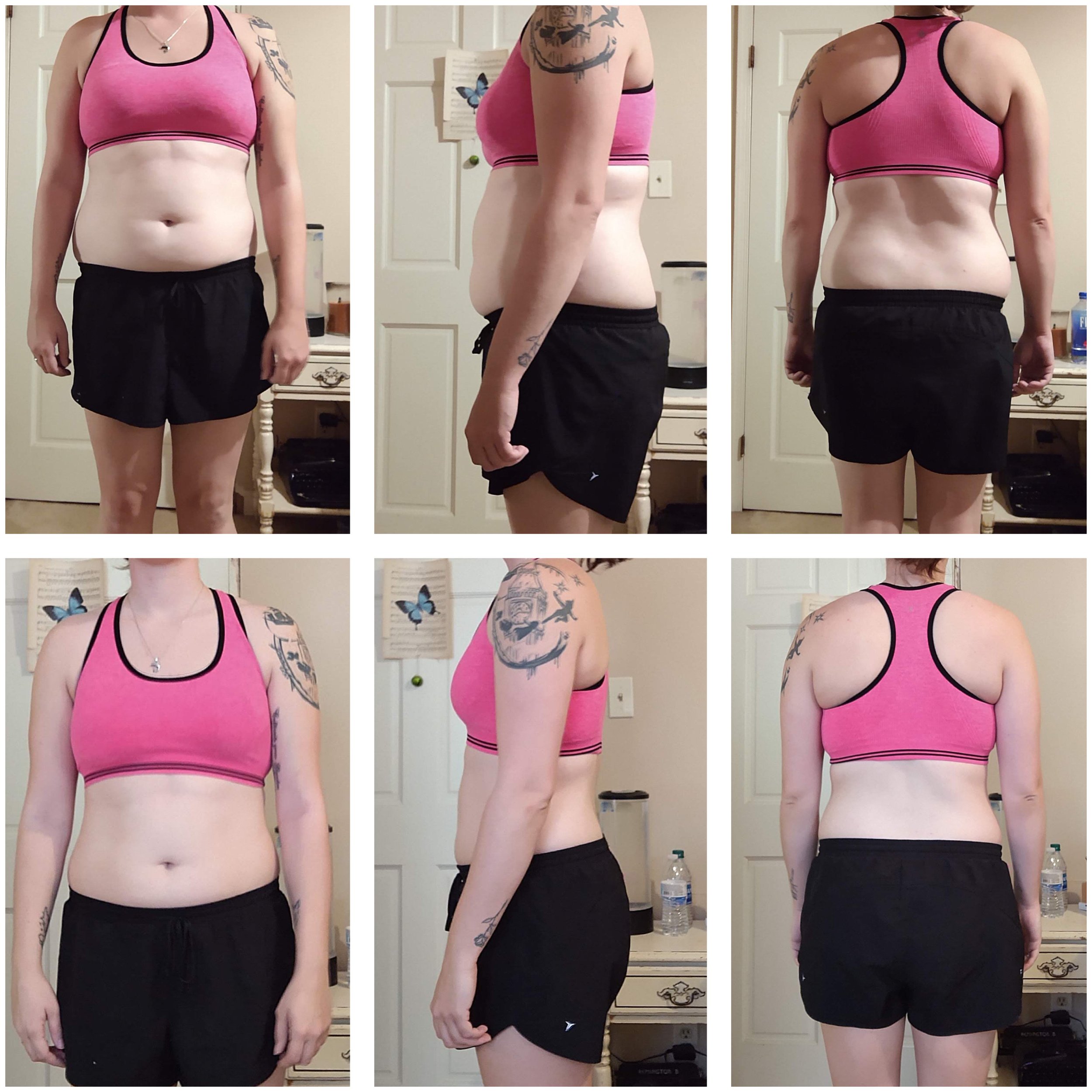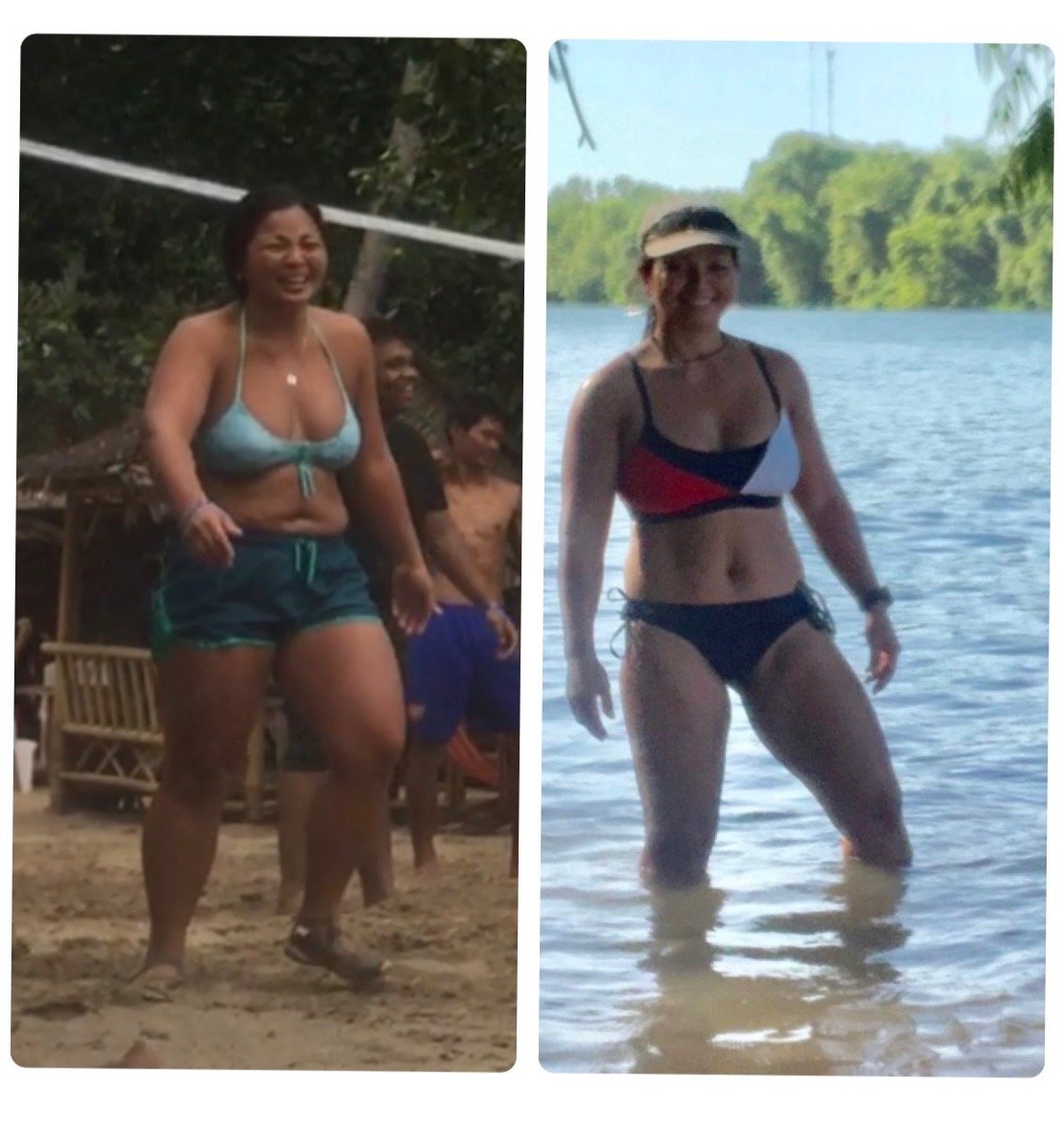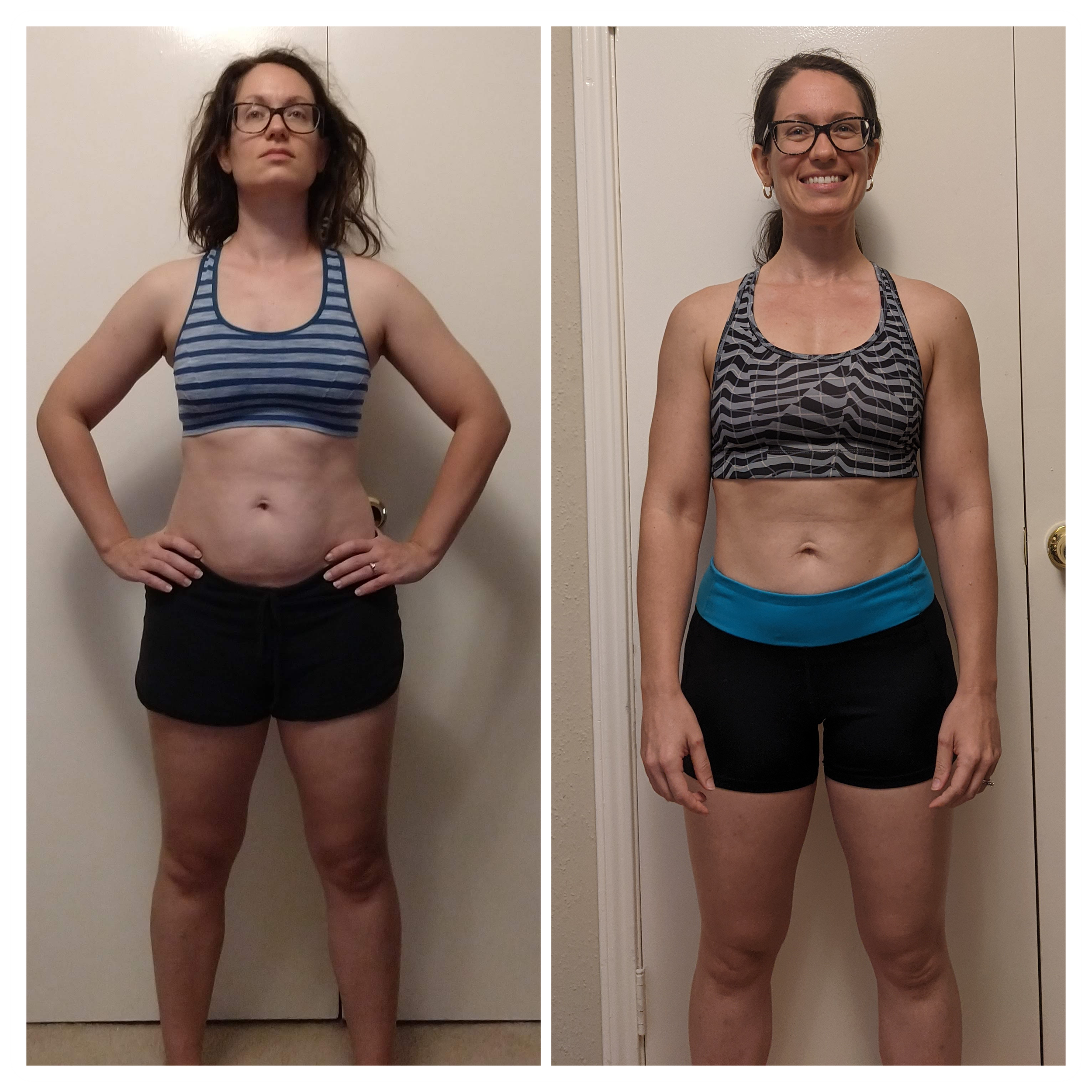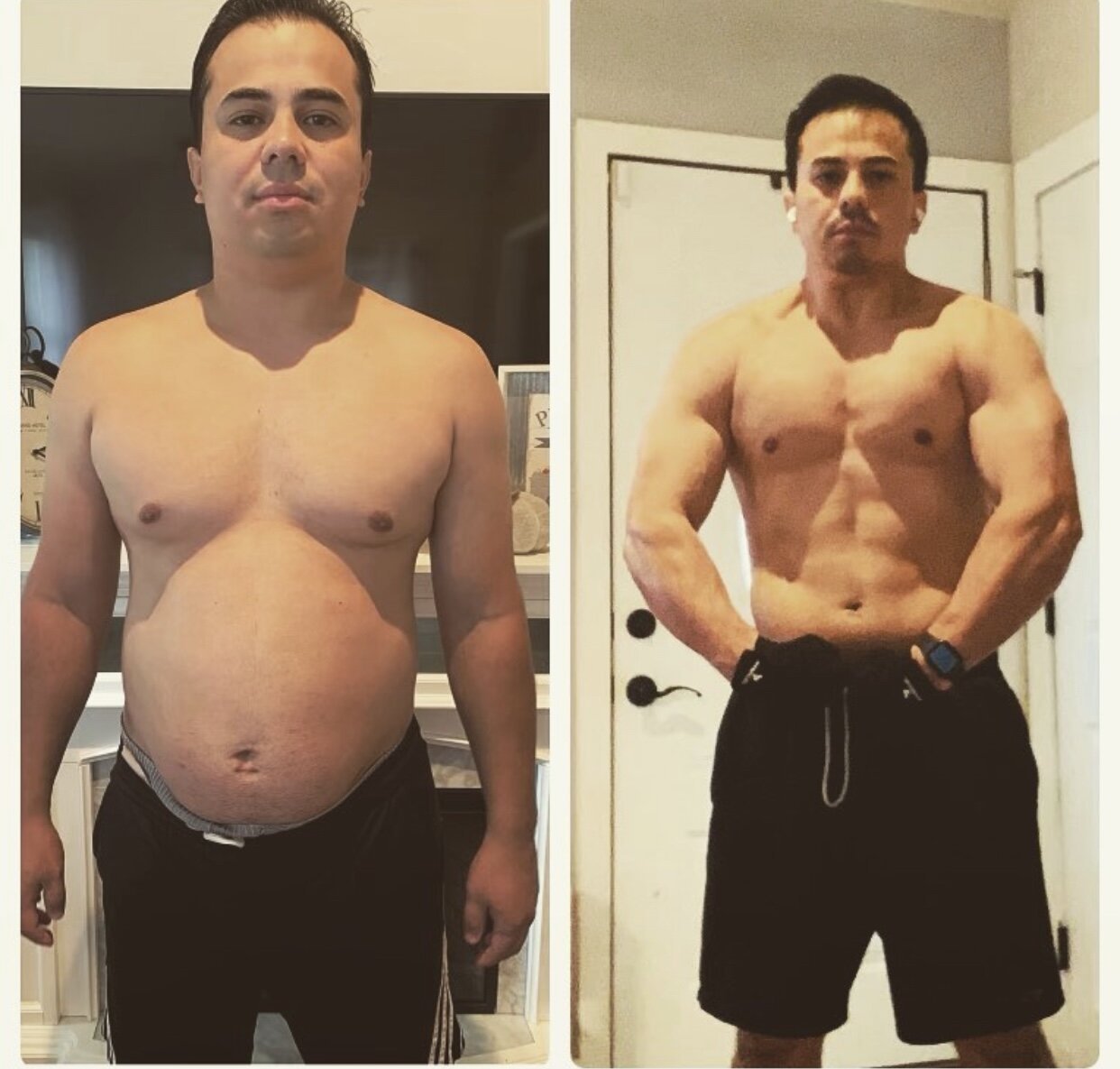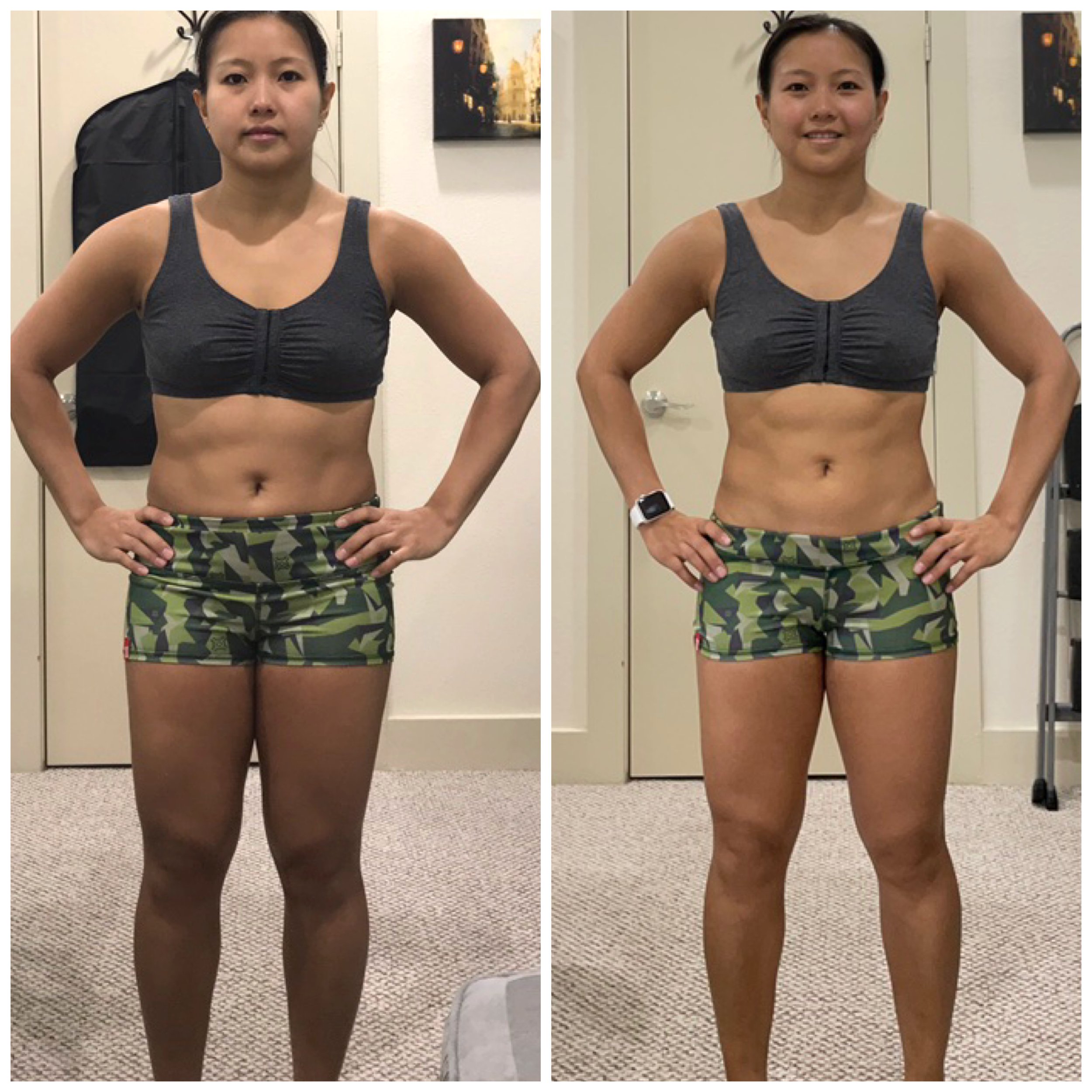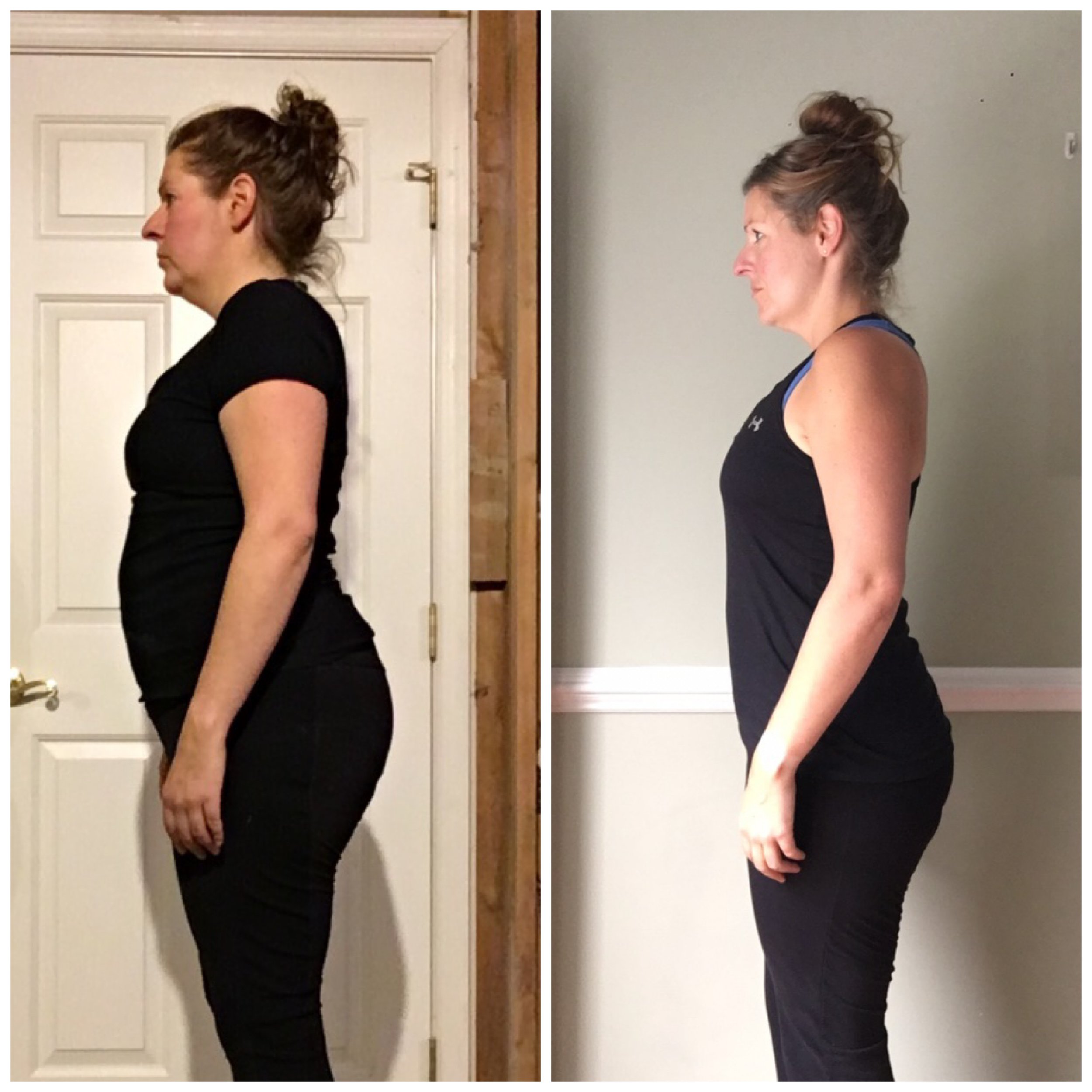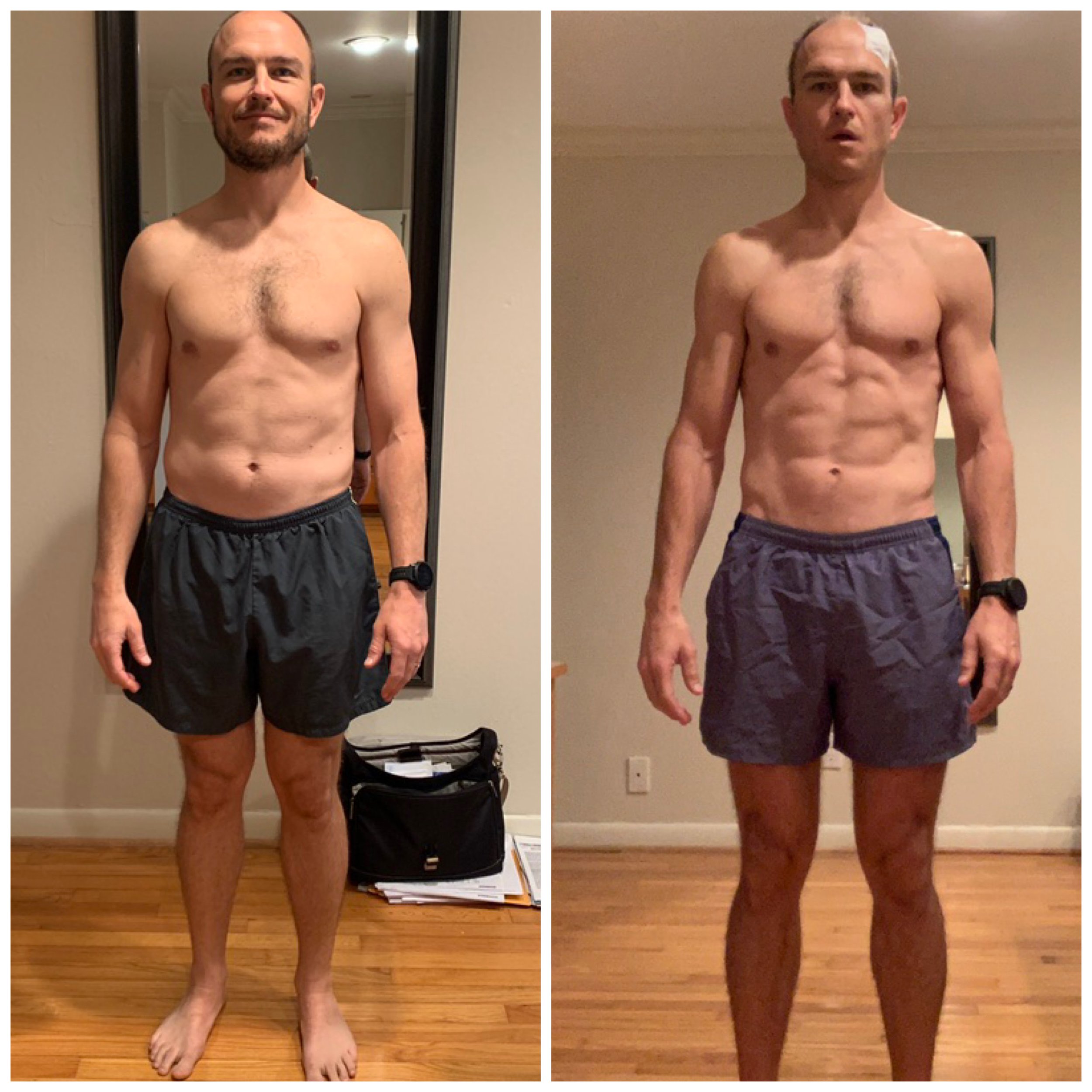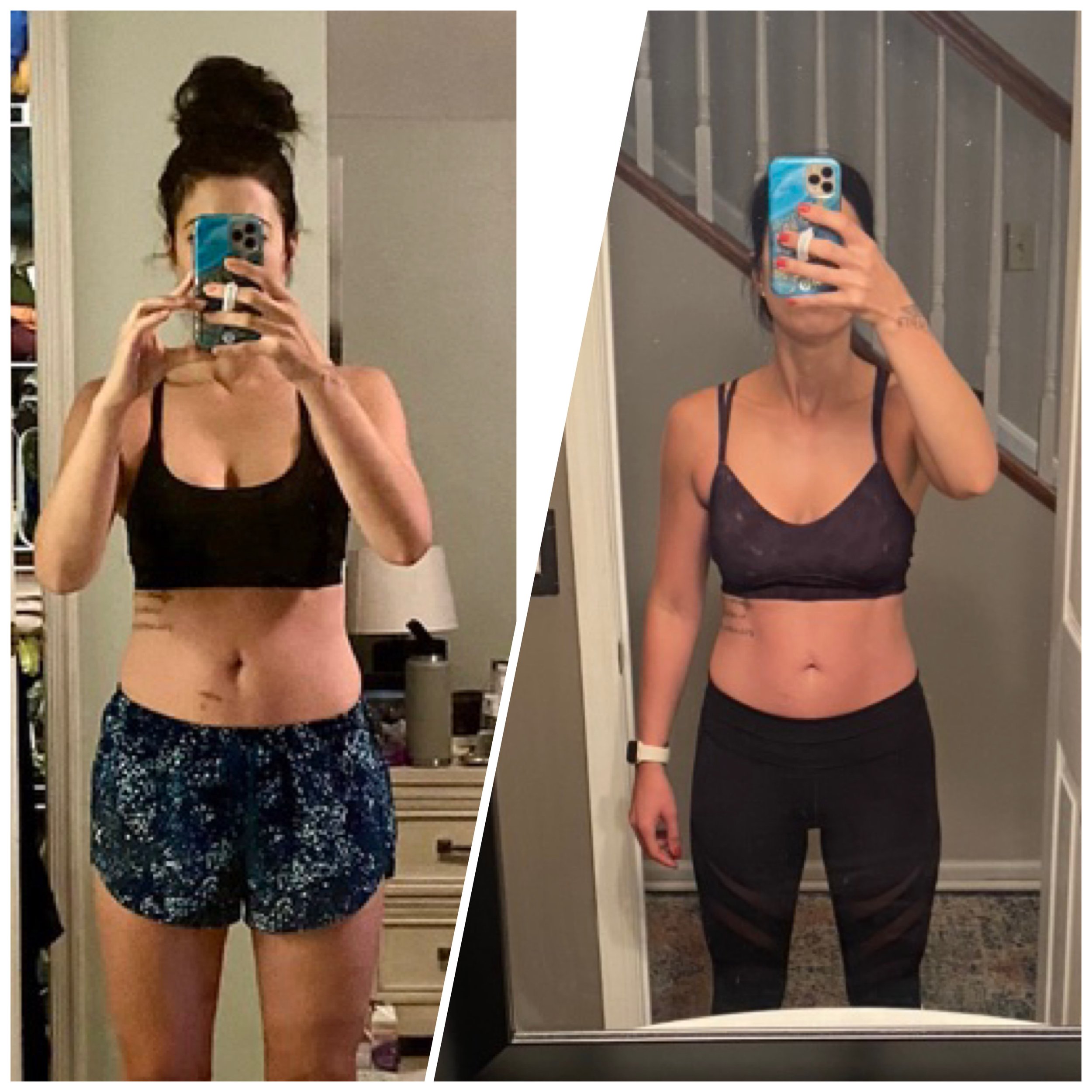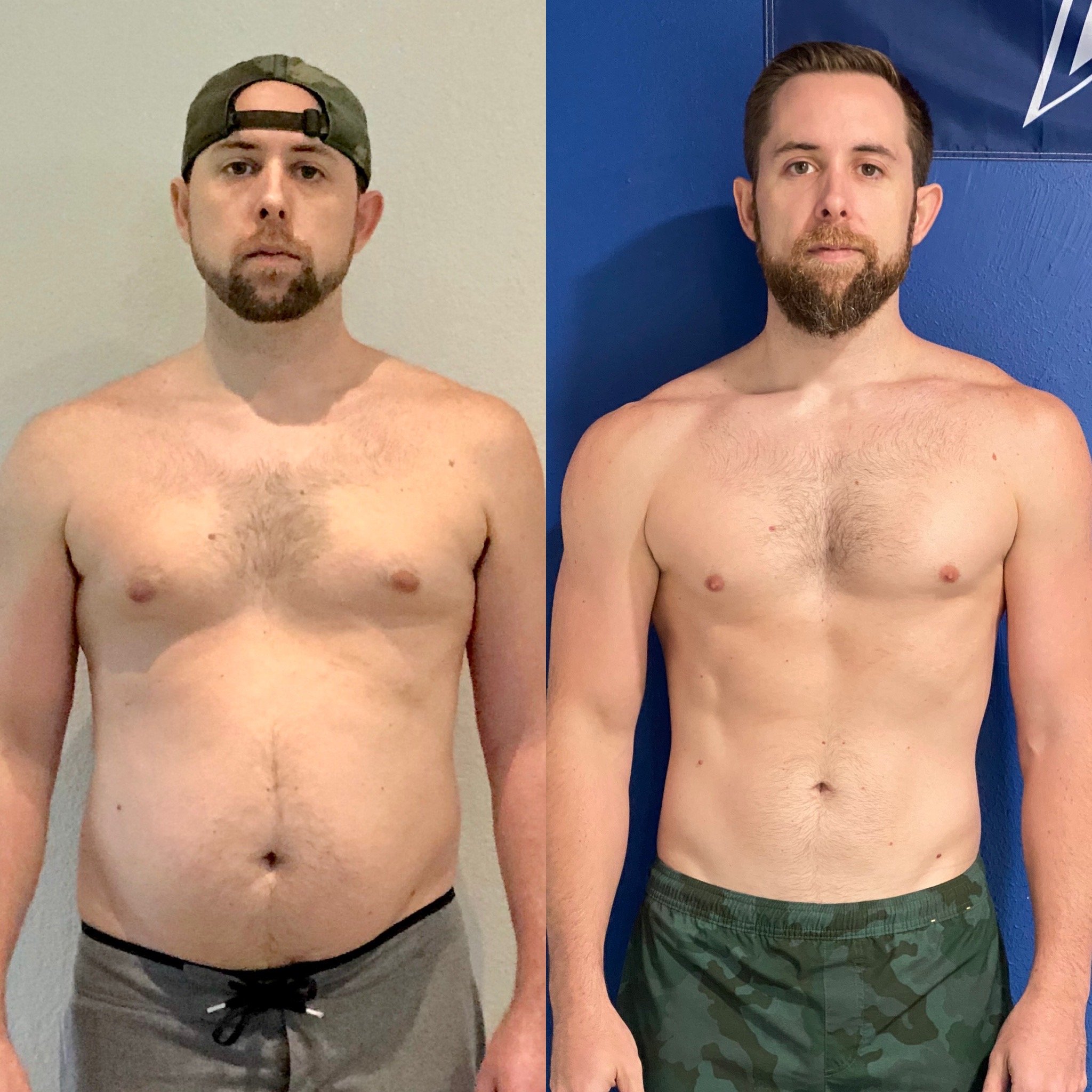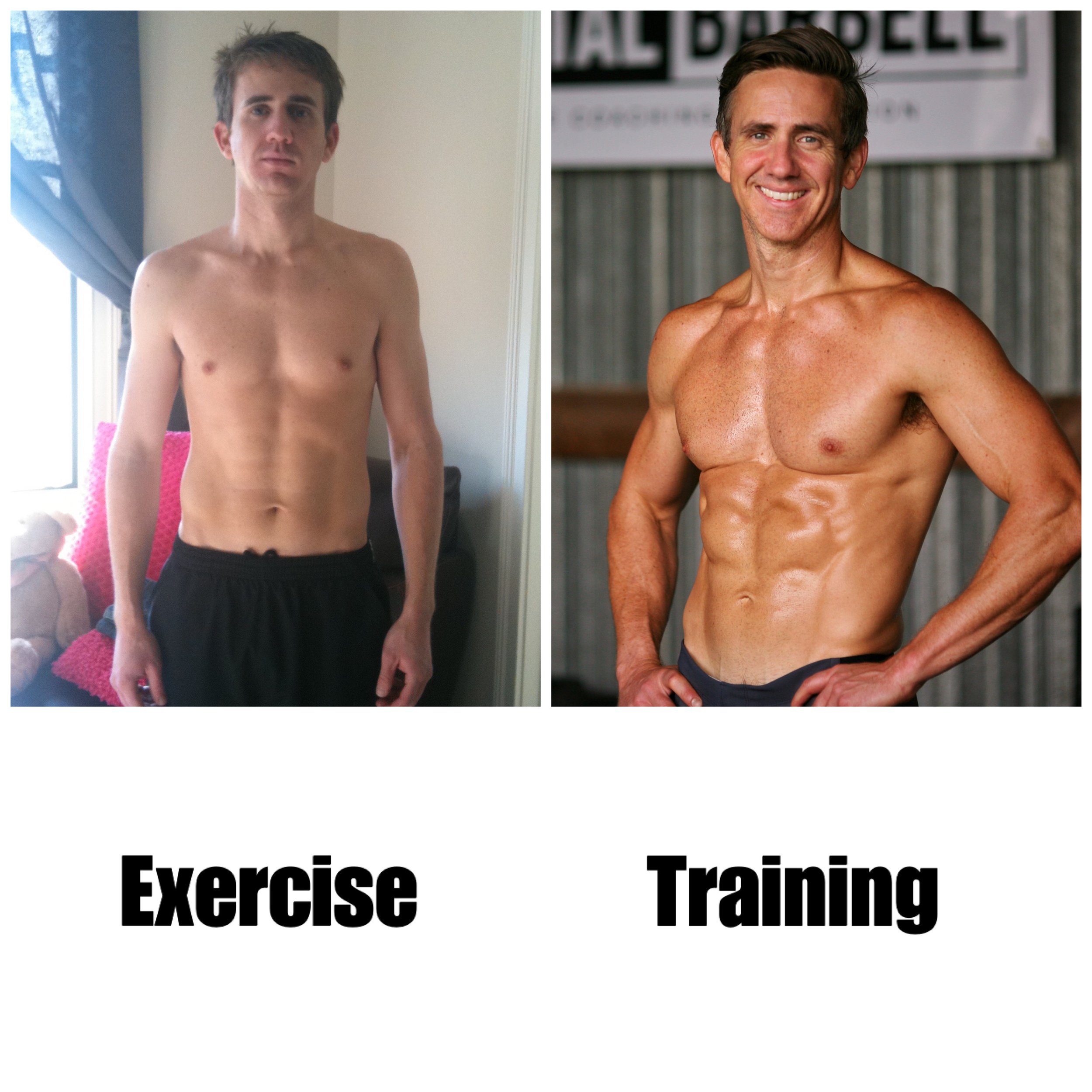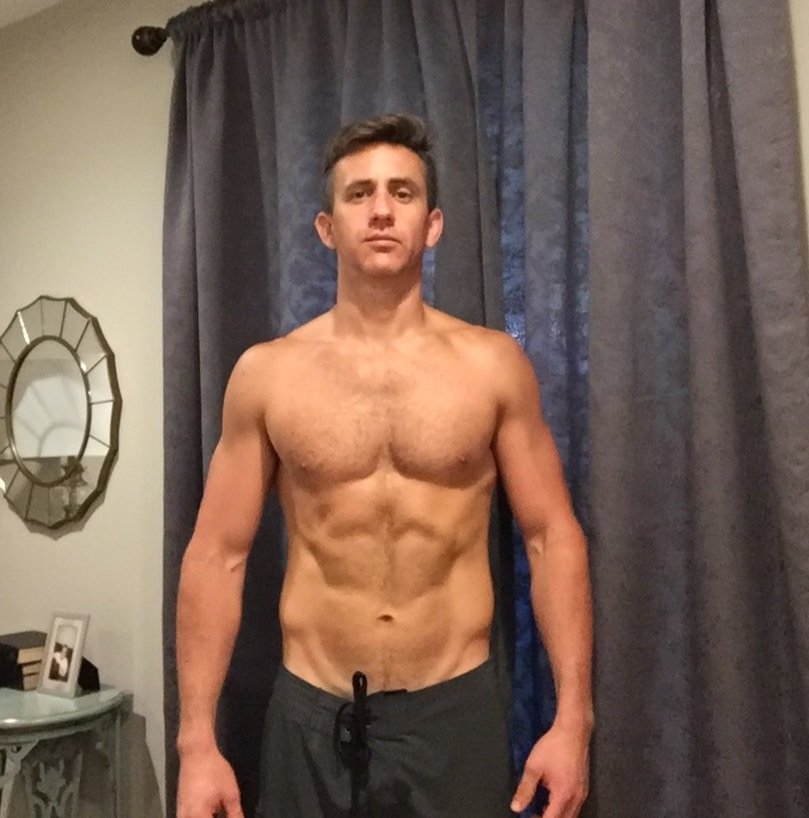Why You Don’t Look Like You Lift & How To Fix It
Do you want to work out and actually look like you do?
You know…actually see your muscles, and look as good as you feel?
Then you've found the right article friend! What we’re going to share can change your results more than anything you’ve tried before.
Before we start, I’ve got a gift for you. For years I worked out with no results to show for it. I put together the 10 Reasons You Might Be Working Out But Don’t Look Like It. I’ll email you every day for 10 days sharing why what you’re doing isn’t working, and what to do instead. Click the button below!
If you’re a visual learner, check out our podcast episode on the topic: https://www.youtube.com/watch?v=z9ZlZwf1qnE&t=637s
If you work out, you deserve to look like it!
Ok, get this…
Imagine socking away 10% of your paycheck week after week for a whole year.
You sacrifice those hard-earned dollars and put them into an investment that is supposed to pay you a higher return than just blowing it on random things on Amazon or simply keeping them in your checking account.
After that year of investing you pull up your statement only to see that the value is exactly the same as what you put in! Your money didn't grow a cent!
Your hard work and sacrifice were pretty much wasted because you picked a loser of an investment. Sad, I know.
This same thing happens all over the world every day in fitness.
People wanting to get fit, change their bodies, and reach their goals are making weekly deposits at their gyms, classes, and garage gyms.
But even after a year of consistent deposits, they pretty much look the same as when they started.
It's not that they weren’t committed or were lazy. It's that they put their training and nutrition resources into the wrong investment. An investment that didn't payout with the physical changes they were looking for.
In other words, they don't look like they lift!
We believe that if you work hard, you deserve results.
So if you want to put in the work, and see the results (look like you lift), we have you covered.
By the end of this article you'll know exactly:
What it means to "look like you lift"
Why you might be working out but not look like you lift
How your diet might be stopping you from looking like you lift
How to avoid getting bulky
How to work out (train) to look like you lift
How to eat to look like you lift (best macros to use)
How long it takes to look like you lift
Supplements that can help you look like you lift
What to do if things aren't working
WHAT IT MEANS TO "LOOK LIKE YOU LIFT"
Let's start by agreeing on what it means to "look like you lift".
Well, obviously these folks look like they lift a TON, but that's not what we're talking about.
We're talking about looking fit, lean, athletic, capable, and having some visible lean muscle tone.
Something like this:
Essentially the "look like you lift" look comes from having a decent amount of muscle, and a low enough body fat percentage that you can actually see muscle definition.
When you've got a good base of muscle, and not a lot of fat you stand the best chance of seeing the definition of the actual muscles, which leads to that defined, toned look.
By the way... We don't think it's vain to want to look as good as you feel. It takes hard work to be consistent with your workouts, and the confidence you get from seeing the physical results of your work is a noble goal!
In other words, go on with your bad self!
WHY YOU DON'T LOOK LIKE YOU LIFT
There are a lot of well-meaning people out there running the streets, crushing Orange Theory classes, Camp Gladiator workouts, CrossFit WOD's, Barry's Bootcamp, SWEAT app workouts, Peloton classes, Pilates, Yoga, F45 classes... Did I miss any?
And while all of these things can be killer ways to exercise, they may never really change your body.
There are also just as many people out there trying to eat healthily. Things like clean eating, the ketogenic diet, the carnivore diet, paleo, Whole 30, intermittent fasting, gluten-free, dairy-free, vegan, and vegetarian... I think that covers most of them.
But do those diets ever lead to an admirable physique? Or are they just another dead-end spend of your limited resources?
Keep reading to find out.
WHY YOUR WORKOUTS AREN'T MAKING YOU LOOK LIKE YOU LIFT
Let's tackle the reason why all of those different exercise programs and classes I mentioned above might not ever get you the results that you want.
First, don't get me wrong… Being sedentary isn't an option. You need to be exercising every single week, multiple times per week if you want to live a long, healthy life. If one of those classes or programs above takes you from doing nothing to doing something, I'm all for it.
But the thing about most classes and programs is that they're not designed with the methods and progressions that take advantage of your natural ability to build muscle and strength effectively.
Remember our definition of "looking like you lift"? A big part of it was actually having a decent amount of muscle on your body. So without that piece of it, you'll just be spinning your wheels.
You might be getting fitter and somewhat stronger in those classes, but to make substantial visual changes to your body, a big part of your training needs the structure of a program focused on building muscle.
The truth is that the more random nature of classes like Orange Theory, CrossFit, and bootcamps is a big reason they fall short on helping you build muscle and change your body.
Your most rapid progress, and your best chance of building muscle, happens when you have staple exercises that you repeat frequently inside a structured program.
We call this idea training. And there's a difference between training and exercise.
SIDEBAR: Speaking of training…We wrote a FREE 5-Week training program specifically designed to build your arms, abs, and glutes. It’s the perfect supplement to group classes or cardio.
And for a limited time, you can grab it for free!
Exercise can mean a lot of different things. Riding a bike is exercise. Doing 100 air squats is exercise. Burpees are exercise.
And exercise is great, but it's not training.
Training is designed to progressively get more and more challenging over time. Because that’s what changes you.
And in our effort to look as fit as we feel, we need to be increasing the weight, and the number of reps on specific repeated exercises over time. More on those specific exercises in a bit.
There's something called the repeated bout effect. What it means is that once you do something a few times, it's no longer a challenge.
So in order to keep getting better, which in our case means building muscle, we need to keep challenging ourselves.
And we use training to make this happen.
The other main reason that classes, programs, and random exercise rarely leads to impressive physique change is that they don't involve heavy enough weights.
CrossFit would definitely be an exception to this rule in many cases. When Blakley (Our head of programming/co-owner here at Digital Barbell) owned a CrossFit affiliate, there was no shortage of heavy weights. But with a limited amount of time for each class, and the need to appeal to a large group, there wasn't enough time to devote to really building muscle.
Also, the high-intensity nature of many CrossFit style workouts doesn’t necessarily lend itself to safe lifting with heavy loads.
Classes and programs that focus on burning a lot of calories, staying in the "fat-burning zone", and ones that have you doing a lot of bodyweight exercises, or moves with light dumbbells are a dead-end when it comes to making you look like you lift. Sorry if that offends you, but it has the virtue of being true.
If you want to change your body, you need to be lifting heavy. When I say heavy, I mean heavy for you, and your abilities. Heavy for some of our clients means 20lb dumbbells, and for others, it means 400lbs on a barbell.
That's the beauty of our training method. It meets you where you are, and helps you get better safely, workout after workout.
Learn more about our method, program options, and pricing by hitting the yellow button below:
WHY YOUR DIET ISN'T MAKING YOU LOOK LIKE YOU LIFT
I'm sure you've heard the expression: "You can't outwork a bad diet".
It's true. Exercise and training don't burn a ton of calories as a whole.
About 60% of your total daily calorie burn comes from just being alive. And even people who train 5 or 6 days per week are typically only burning a few hundred calories per workout.
That’s about 3 handfuls of tortilla chips.
How Your Daily Calorie Burn Breaks Down
Only a small percentage of your daily calories are burned through exercise.
We've worked with hundreds of people through our 1-on-1 nutrition coaching services.
From that experience, I can tell you that there are some common threads that hold people back when it comes to the parts of their diet that are keeping them from looking like they lift.
By far the biggest factor is that people aren't eating the right amount of food.
This is a huge topic, and it's the #1 thing that will drive whether you're headed in the right or wrong direction with your body.
If you're overweight and are carrying too much body fat, it's time we get you into a calorie deficit. What that means is that we need to help you figure out how many calories you're already eating most days, and pull back a little.
I say "a little" on purpose. It can be tempting when we you fat to lose to try and take an aggressive approach to make progress happen quickly.
But remember our overall goal. To look like we lift. And what do we need to look like we lift?
Muscle!
An aggressive calorie deficit can absolutely lead to muscle loss, and we don't want that.
The other downside of an aggressive calorie deficit is that even if you can stick with it for a week or two, hunger is going to catch up with you.
And that hunger will more than likely push you to overeat, and potentially wipe out the deficit you worked hard to create.
We created a free tool that can help you set your calorie deficit without risking muscle loss Download it below. Did I mention, it’s free?
Even if you're not overweight, the quantity of food you're eating is still important in your quest to look like you lift.
Have you ever heard the term "skinny-fat"?
What it means is that you're not overweight, and you look pretty thin with your clothes on, but if you were to take your shirt off or wear a bathing suit, things would be less than impressive.
Essentially, skinny-fat is a loose, sorta flabby look caused by not having much, if any muscle on your frame.
When it comes to skinny-fat and nutrition, these folks are often not eating enough calories.
Building muscle takes calories. More specifically, it takes an abundance of calories, or a calorie surplus.
Our free calorie calculator tool has a category for our skinny-fat, or under-muscled friends as well!
Another common problem we help people overcome with their nutrition is that they aren't eating the right kinds of foods for their goals.
Even if your training is dialed in and you're eating the right amount of food, the actual foods that you pick matter too.
Pick up any magazine or scan the shelves of any grocery store, and you'd think that the secret lies in "going vegan" or slashing carbs.
And while you can get bigger and stronger with a vegetarian or vegan diet, it's going to take some work.
We talked about it in this article below:
The challenge with a vegetarian or vegan diet is getting enough protein.
The protein in your food gives your body the building blocks of muscle called amino acids.
Not enough protein = not enough muscle.
And while most foods have some protein, it's much easier to get enough for real muscle growth through animal sources like eggs, meat, and dairy. Vegans and vegetarians can still look like they lift, but it takes some extra work.
One thing is for sure though... If you're trying to look like you lift weights, going low-carb or keto is like trying to head up a steep hill on a child's bicycle.
It's going to be tough!
Your body loves to use carbs for energy. In fact, if you’re doing it right, (and you will be after reading this article) lifting weights is almost exclusively powered by the carbs that you eat.
Can you lift weights on a low-carb diet? Yes. But if your goal is to turn heads because you look like you lift, carbs are your friend.
We'll talk about how much protein and carbs are right for you in a bit.
If you're liking what you're hearing, but are intimidated by tackling your nutrition on your own... We can help.
We work 1-on-1 with people just like you in our Nutrition Coaching services.
HOW TO AVOID GETTING BULKY FROM LIFTING WEIGHTS
Are you afraid that by lifting weights and eating more calories/protein you'll end up looking like a bulky, muscle-bound superhero by accident?
We've worked with tons of men and women who wanted to build a lean, fit, athletic, toned body without looking bulky.
Guess what? We have good news. You're in no danger of ending up looking like a monster.
There are 2 main factors at play here in this "look like you lift" game.
1 - Your Training
2 - Your Nutrition
They both have their own separate roles in the game.
Is there one particular body part or muscle group that you want to give extra attention to? We can adjust your progress by how much total volume (how many sets and reps) you do per week in that area.
And then we can use that same principle in reverse to keep one muscle group from growing as much.
Want bigger, more defined calves? No problem!
Want stronger, leaner arms? We can do that!
Keep in mind, muscle growth happens sloooooooowly.
There's no chance you are going to wake up one day and not like the way you look compared to yesterday.
If it were that fast and easy to build muscle, there would be a whole lot more jacked people walking around, and we'd be out of a job.
Beyond the fact that building muscle takes a long time, it also takes a lot of calories.
In other words, your nutrition matters a ton if you're trying to avoid getting bulky.
Muscles either get bigger, or they don't. Remember how we said that you need a calorie surplus to build muscle?
Well, the size of that surplus matters. The way to get "bulky" is to eat too much.
Because when you picture "bulk", what you're seeing is muscle, with extra fat covering the muscle. That’s what’s giving it the “bulk”.
So to avoid getting bulky, use a conservative calorie surplus instead of an aggressive one, and you'll minimize your chances of gaining bulky fat as you get more jacked.
Again, we've got a free tool to take the mystery out of this HERE.
HOW TO WORK OUT (TRAIN) TO LOOK LIKE YOU LIFT
Ok, let's get into the really fun stuff, and one of the most important things to nail if you want to look like you lift.
The things that you do in the gym!
We talked earlier about the reasons why you might work out for years and years and never look much different.
Remember, if you really want to change your body, you need to TRAIN and not just EXERCISE.
Group classes and cardio like Orange Theory, Peloton, Camp Gladiator, HIIT, and the like can be great exercise assuming they're programmed and coached safely and effectively.
They can get your heart rate up for an hour, and make you feel like you're going to meet your maker, but here's the truth. All of that exercising is just making you better at exercising.
You're increasing your capacity to do those classes, and they'll get easier and easier over time if you're consistent.
And since the classes can only be so long (who has time for 2 hour long workouts?), and you can't safely sling heavier and heavier weights around, your results plateau quickly.
That's the problem with a workout program built just on exercise.
It doesn't take advantage of your body's natural ability to build strength and build muscle.
And if you remember, building strength and muscle are key if you want to look like you lift.
Training is different than exercise.
Training has a progression that takes advantage of your body's natural abilities.
Proper training keeps you from hitting a plateau by changing over time with a purpose.
We call this process progressive overload.
THE IMPORTANCE OF PROGRESSIVE OVERLOAD TO LOOKING LIKE YOU
It's pretty much what it sounds like, but let me explain how it works with an example.
Let's say you buy a calf. No, not the muscle on the back of your leg, a baby cow.
Your adorable calf was just born so it only weighs 65lbs.
Day 1, you pick your new pet up off of the ground, hold her against your chest and walk across your front yard. Imagine what your neighbors must think!
65lbs isn't exactly light, but it wasn't too bad. You go about the rest of your day, and get a good night of sleep.
Day 2, you're a little sore, but you pick up your little buddy (Let’s call her Tina) and carry her across the yard again. You notice that it wasn't quite as hard today.
You keep this routine up every day for two weeks.
By day 14, Tina weighs 85 lbs since she's drinking milk like it's her job. But amazingly, she feels light in your arms.
How can it be that your 85lb baby cow is easier to pick up today than she was two weeks earlier at 65lbs?
Because you trained using progressive overload.
Every day you carried Tina, and then recovered by eating food and sleeping.
That process causes your body to make an adaptation so that you're a little stronger after you recover.
Every day, Tina got a little bit heavier, and your strength kept up because you were training it to do so!
If she stopped growing at 70lbs, your strength would have plateaued right there.
Here’s the lesson…The weight you lift and the amount of work you do must get more challenging over time. Your “cow” has to get bigger in order for you to keep improving.
Let's translate this silly example over the gym setting and talk about how we can use training and progressive overload to look like we lift.
The great part about this is that it works whether you're a total beginner or you're an advanced lifter.
Beginners don't need their training to be as complex as intermediate and advanced trainees, but the principles remain the same.
TRAINING FOR STRENGTH TO LOOK LIKE YOU LIFT
Ok, listen up. To look like you lift, you need to train for whole-body strength.
What that means is that you want to structure your training time to do the exercises that hit a lot of muscles all at once.
We call these types of exercises compound exercises. These multi-joint moves like the squat, deadlift, press, bench press, rows, and lunges not only use a lot of muscles all at once, they can be loaded with more weight than doing just single-joint exercises like curls or kickbacks.
Not only is this a better use of your training time, but when you lift heavy weights (like we can with the compound lifts) your body ramps up the production of the hormones that help you grow muscle.
In other words, your squats are going to help you grow better-looking arms if you do it right.
A lot of people trying to change their physique miss out on a huge chunk of their potential because they don't know the benefits of building whole-body strength.
They simply go to the gym, grab light weights, do the machines, and head home. Bad plan!
I mentioned earlier that the compound lifts can be loaded heavily. Heavy is a relative term. What's heavy for me may not be heavy to you, and vice versa. And that's perfectly fine!
The beauty of building strength and muscle is that no matter where you start from, you can make gradual improvements through progressive overload.
When we talk about lifting heavy, form and technique matter. We pride ourselves on keeping our clients safe, and that's why our team coaches every single one of their clients. Again, form matters.
Speaking of form… Deadlifts are one of the most important exercises to loo like you lift. Maybe you’ve been nervous to do them or have gotten hurt deadlifting in the past? We just released “THE ULTIMATE DEADLIFT GUIDE”.
The only resource you’ll need to get the most out of deadlifts, without getting hurt. And of course it’s FREE! Just click the button below to get your copy today.
Let's touch on exactly how to use progressive overload to look like you lift when it comes to these compound lifts.
Our preference for most clients is to program their strength exercises in sets of 5-8 reps. Let me explain why.
We know that we need to be lifting heavy (for us). More specifically, most of our strength progress will be made when working with weights that are about 80 or more percent of the amount you could lift for 1 rep. We call this your 1-rep max. Don't get too hung up on what your 1 rep max is for now.
Since we're working with weights that are pretty challenging, we reduce the risk for injury by keeping sets in the range of 5-8 reps. Also, maybe you've noticed that doing super high-rep squats or other movements with any amount of weight can make you incredibly sore.
Soreness isn't a sign that you had a great workout, and getting super sore can actually keep you from training effectively which is a real progress-blocker.
Using progressive overload can look many different ways, but here are the two most common ways that we use it with our clients to ensure they're getting stronger and looking like they actually work out.
HOW TO USE LINEAR PROGRESSION TO MAKE STRENGTH PROGRESS
Linear progression is the simplest form of progressive overload, and it's a great way for beginners to make rapid progress.
Here's a simple example of what linear progression would look like on your bench press:
Week 1: 3 sets of 5 reps at 165lbs
Assuming you were able to do all 5 reps each set, we would increase the load (weight) for your next bench press workout, and keep the reps the same.
Week 2: 3 sets of 5 reps at 170lbs
Doing your bench presses each week is like picking up your pet cow (remember Tina?) each day. You eat, sleep, and come back stronger for your next workout.
If you were to plot your strength improvement on a graph, it would look like... wait for it.... A LINE! AKA - "Linear Progression!
As I said, this is a tremendous way to build strength quickly. I took my squat strength from 250lbs to 370lbs in 3 months using this method, and we've helped many people make similar gains in a similar amount of time.
HOW TO USE DOUBLE PROGRESSION TO GET STRONGER
The other most common way to use progressive overload in your training is called double progression.
Unlike linear progression, we don't simply keep the reps the same each workout and add weight if we were successful.
With double progression, we manipulate both the number of reps, and the amount we're lifting from workout to workout.
We start with a rep-range in mind that we want to work within. Let's stick with 5-8 reps since we used it earlier.
Using double progression, we would do our 3 sets of 5-8 reps at the weight we chose, and then record how many reps we got. More later on how hard you should be pushing yourself on each set.
Once we are able to do all of our sets at the top number of our rep range, we add weight to that exercise the next time we do it.
In real life, you might get 8 reps on your first set, 7 reps on your second, and 6 on your last set.
Next week maybe you'll get 8,8,7, and 8,8,8 the following week. Then you're ready to add weight next time, and your reps will probably dip back down closer to 6 reps per set.
Since you've got two variables to work with, you can make progress for a really long time using double progression without getting more complicated.
HOW TO USE HARD SETS & RATE OF PERCEIVED EXERTION (RPE) TO BUILD STRENGTH, MUSCLE, AND LOOK LIKE YOU LIFT
One of the problems with group classes, and not having a coach, is that you don't really know how hard you should be pushing yourself.
Should you be maxing out? Should you do a whole bunch of reps until you feel the burn? Should you go to failure?
We had these same questions for many years, and we wasted a lot of time doing it wrong.
Now we work with a lot of people with all different levels of experience, and the most common thing we find in people who feel like they're working hard but not looking better is that they aren't pushing themselves hard enough.
Even if they're lifting weights, they're stuck because of the intensity that they're bringing to the table.
Effort matters. And the reason why it does is backed by science. Research shows us that muscle growth, and strength gains happen best when working with intensity.
In weight lifting we use a subjective scale of effort to rank how hard an effort was. We call it the RPE scale. It stands for "Rating of Perceived Exertion".
The scale goes from 0-10. An RPE 10 is an all-out effort. Your eyeballs were popping out, your face was red, and there's no way you could have done another rep.
As you work backward down the scale toward zero, you're ranking how many reps you could have done but didn't.
In other words, if you rank a set as an RPE 8, you probably could have done 2 more reps if you had to.
As I said, this ranking is subjective, and that's one of the benefits to having an experienced coach watch your sets. Wink wink.
So what RPE should you be working at most of the time? Of course it depends on several factors like your experience, age, the load you’re lifting, and the exercise you’re doing. But if you're trying to look like you lift, you need to be living in the RPE 7-8 range most of the time.
Around here, we call a set at about RPE 8 a "hard set", and we use the terms interchangeably.
I mentioned that we find that a lot of people are trying to make progress, but aren't... The reason is that they don't realize that everything they're doing is closer to an RPE 4 or 5 than an RPE 8.
This one change alone, combined with the right program, and consistency can have you seeing more visual progress in a few months than you have in years.
THE ACCESSORY EXERCISES YOU NEED TO BE DOING TO LOOK LIKE YOU LIFT
I talked earlier about the importance of doing your squats, deadlifts, presses, bench presses, rows, and lunges.
But that's not all you need to be doing if you want to look like you actually work out.
This next section is important so pay attention!
Back in 2014 I had a back injury. At the time I was doing almost 100% strength training. And while I did get strong, I certainly didn't look like I wanted to.
Strong, but not the look I was hoping for
I wanted to keep training while my back healed, but I wasn't ready to get back under a heavy barbell. It was that injury, and the desire to keep making progress while recovering, that really opened my eyes to the power that doing the right bodybuilding exercises with the right progressions had to change my body.
I did as much research as I could, and I tested. And then I tested some more. And then I grabbed some friends, and tested on them.
And with patience, consistency, the right plan, and hard work, a lot changed. Nutrition played a huge roll in these photos too, but don’t worry, we’ll get to that.
Whether you're young or old, man or woman, if you want to look like you work out, you've got to be doing the right "accessory" exercises at the right dosage and intensity.
We call them accessory exercises because the compound lifts we talked about earlier are the main feature of your training, and these other exercises are there to compliment them.
If you come from a CrossFit, or other group class background like we did, you may never done many of these isolation-type exercises, which means you're in a place to make some great progress as I did, and like our clients have.
If what you’re doing now isn’t working…
That means you’re primed to make rapid progress with a better program.
If you've really only ever done cardio or things like Peloton, Yoga, Spin, or running, you're in luck too. Doing these other exercises with the right progression really can change your physique.
When we work 1-on-1 with our clients, we tailor their programs to help them reach their specific goals. But we're here to help. So here are some ideas of what accessory exercises you should be doing regularly in your workouts if you want to look like you lift.
In our experience, most men want to give more love to their upper bodies, and ladies want to give a little more attention to their legs and glutes.
For that reason, we've put an * by the exercises that most women want to emphasize, and an ^ next to the ones that men should hit most often. Again, all exercises are for all people, but that doesn't mean we all need to do the same amount of each.
Shoulders:
Dumbbell Presses * ^
Arnold Presses * ^
Lateral Raises * ^
Chest:
Dumbbell Bench Presses * ^
Incline Dumbbell Bench Presses ^
Incline Bench Presses ^
Close Grip Bench Presses * ^
Chest Flys ^
Deficit Pushups * ^
Dips ^
Back:
Pull-ups * ^
Chin-ups * ^
Lat Pull-Downs * ^
Seated Rows * ^
Dumbbell Rows * ^
Face Pulls * ^
Reverse Flys * ^
Triceps:
Cable/Band Push-Downs * ^
Skull Crushers * ^
Lying Tricep Extensions * ^
Dips ^
Dumbbell Overhead Tricep Extensions * ^
Incline Skull Crushers * ^
Biceps:
Barbell Curls * ^
Dumbbell Curls * ^
Hammer Curls ^
Arnold Curls ^
Incline Curls ^
Preacher Curls ^
Concentration Curls ^
Banded Curls * ^
Legs/Glutes:
Hip Thrusts * and ^
Hip Extensions * and ^
Quadruped Hip Extensions *
Goblet Squats * ^
Heel Elevated Goblet Squats * ^
Front Squats * ^
Weighted Step Ups * ^
Weighted Lunges * ^
Romanian Deadlifts * ^
Sumo Deadlifts * ^
Calf Raises * ^
Abs:
Suitcase Holds * ^
Planks * ^
Side Planks * ^
Hanging Knee Raises * ^
Hanging Leg Raises * ^
If you don’t know how to do one of these exercises, don’t sweat it. We have video demos of everything on our YouTube channel. We’re always adding new ones, so make sure and subscribe.
Ok, you're armed with a huge list of exercises that will help you build muscle, and make you look as good as you feel. Are you overwhelmed with what to do with all of this information?
I would be too!
The truth is that there are too many factors to write a one-size-fits-all training program for every single person reading this article. That’s the reason that we work 1-on-1 with our clients to tailor their programs to their goals, schedules, and abilities. But let me get you started by building you a 3-day accessory workout plan.
This is meant to be added to your CrossFit, Orange Theory, Peloton, or whatever group classes you’re already doing.
SAMPLE ACCESSORY WORKOUT
Pick 2 or 3 exercises from each category/muscle group.
On day 1 of the week, do the chest, tricep, and shoulder exercises after your strength work or class. Do 2-3 "Hard Sets" of each. Remember those from earlier? Finish the workout off with 2-3 hard sets of ab exercises. We'd recommend that you do your bench press and/or overhead press strength work on this day.
On day 2 of the week, do the back and bicep exercises you picked, 2 more ab exercises (it's ok to repeat the ab exercises from day 1), and finish off the workout with some simple low-intensity cardio if you have time. Again, do 2-3 hard sets of each. We'd also recommend that you do your deadlift strength work on this day before doing this accessory work.
On day 3, do your squat strength work, along with 2-3 hard sets of the accessory lifts you chose for your legs. Finish off with 2 more hard sets for your abs, and call it a day.
This is a classic "push/pull/legs" workout split and is a tried and true way to make gains for a long time.
If you love doing CrossFit, Orange Theory, F45, Barry's Bootcamp, Camp Gladiator, SWEAT APP workouts and you don't want to give them up, you don't have to.
Adding the exercises we just went over to your training can still give you great results.
If you're in this for the long haul (you should be), you'll want to make sure that you're adding more hard sets to your week over time, and that you're not doing the same exact exercises month after month.
Remember, your body adapts to what you do, so you have to continue to challenge yourself to keep making progress. #remembertina
SHOULD YOU DO CONDITIONING IF YOU WANT TO LOOK LIKE YOU LIFT
Let's talk briefly about cardio/conditioning.
If the goal to look like you lift is reached by building muscle and keeping body fat low, you should make time for some conditioning. Not to mention how cardio improves your heart health.
We schedule 2-3 days that include cardio for ourselves and in most of our training client's programs.
Our approach to cardio is different than most other programs and coaches. Instead of having our clients pound the pavement jogging for a boring 20-30 minutes, we take the opportunity to get creative and make conditioning fun and multi-purpose.
We structure our conditioning in a way that lets us sneak in extra muscle-building volume while keeping our heart rate elevated in different ranges. It's a win/win scenario.
If you've heard that you should do extra cardio just to burn calories, that's not a great use of your time.
Controlling your nutrition does a much better job of that, so let's dig in.
WHAT AND HOW TO EAT TO LOOK LIKE YOU LIFT
We talked earlier about the common reason that people's nutrition keeps them from looking like they lift.
The big reasons were:
Not eating the right quantity of food (calories)
Not eating the right amount of protein
Not eating the right amount of carbs
I'd like to add a very important 4th one to the list right now. Actually, it is the most important one of all.
***Not being consistent and patient enough***
I get it, we all want instant results, and we want to see 100% progress with 50% consistency.
But unfortunately, that's just not reality. I told you earlier that muscle building is a slow process. Think months and years, not days and weeks.
So as you read this section on how you should eat to look like you lift, know that you're not going to look different on day 2 or 3. And keep in mind that staying on top of your nutrition Monday through Thursday is only 57% consistency, and that's not enough to get results.
Most of the people you see with impressive physiques did it over the span of 3-10 years, at 80-90% consistency, not during a 30-day challenge.
Ok, on to the details of how to eat to look like you lift.
Let's start with food quantity or total calories.
PEOPLE WHO NEED TO LOSE BODY FAT TO LOOK LIKE THEY LIFT
Men, if you're over about 15-16% body fat it's time to focus on fat loss. Ladies your number is about 25%.
We talked earlier about the importance of creating a calorie deficit to cause fat loss. You need to eat fewer calories per day/week than you're burning.
That will cue your body to burn your body fat to make up the difference.
You've got to do this for an extended period, not just for 1 or 2 weeks. Your body takes time to respond.
It's not uncommon for our clients to maintain a calorie deficit for several weeks consistently before fat loss starts kicking in at a nice pace.
So how big of a calorie deficit should you use, and how do you figure out what it should be?
The easiest way is to download our free tool below:
If you're going to be tracking your calories, you'll need to get familiar with using an app like MyFitnessPal. We wrote a blog about how to track your food without messing it up. Check it out below:
Just like anything, you'll pretty much stink at logging your food when you start. But as you practice, you'll get better and better and faster and faster. So don't give up.
As a general rule, you should be shooting to lose about .5-1% of your body weight per week when you're in a fat-loss phase. We'll talk about how to measure that in just a bit.
WHAT TO DO TO BUILD MUSCLE AND GAIN WEIGHT TO LOOK LIKE YOU LIFT
If you're already pretty lean, under-muscled, or skinny-fat you need calories. It's so common in today’s "constantly dieting" culture to think that it's awful to think about gaining weight.
But this kind of thinking is one of the main reasons that people will exercise and work out for years and years and never look any different. They aren't giving their body the fuel to grow and change!
Ok, I'm off my soap box.
If you're already in the 10-12% body fat range for men, or 15-20% range for ladies, but you don't look like you lift, it's time to eat!
But before you order a pizza, head to Golden Corral, or start slamming weight-gain powder by the fistful, let's pump the brakes.
It takes calories to grow, but maybe not as many as you might think.
If you didn't download our free tool to help you set your calories earlier, go do it now.
Use the "Lean Bulking" numbers inside.
Research shows that a calorie surplus of 10-15% over and above your current maintenance calories is the sweet spot to pack on as much muscle as possible without gaining a bunch of unwanted body fat.
We call this process "Lean Bulking", and we have a short podcast episode with everything you need to know: https://youtu.be/Y9ZPAqiypmY
To lean bulk right, and end up looking you lift, you should aim to gain about .25-.5% of your body weight per week.
HOW TO TRACK YOUR PROGRESS
Whether you're trying to cut body fat or gain muscle, it's important to track your progress. You probably already know that your weight is one way to measure your progress.
We recommend weighing yourself as often as you're comfortable with (ideally every day), and calculating your average weight each week. Your weight fluctuates 1-2% or more daily depending on a lot of factors that don't have anything to do with fat loss or muscle gain.
Things like:
Water retention from salty food
Poor sleep
Extra stress
A tough workout
Undigested food in your stomach
Women's month cycle
Weighing yourself 7 days per week and getting your average weight gives you a clear way to steady out those fluctuations and get a more accurate picture of how your weight is changing from week to week.
Another important way to measure your progress is to measure yourself.
Get yourself a flexible tape measure, and take notes.
Use the guide below to take your body measurements every 2 weeks.
Last but not least, take progress photos. I know ,I know, you're self-conscious and don't want to take them.
Do it anyway. You'll be glad you did when you look like a superhero. Use the guide below to know how to take great progress photos every 4 weeks.
Don't just try to compare your photos month to month by swiping through your phone. You'll never be able to get a good picture of your progress.
Use an app like Photogrid on your phone to put those suckers side by side and you'll really see what's going on.
HOW MUCH PROTEIN SHOULD YOU EAT
Now that we've talked about how many calories you need to be eating to look like you lift, let's move on to the most important nutrient that can help you change your body composition, and make you look like a Greek god or goddess.
I'm talking about protein. 🍤 🥩 🥚 🥛
Your muscles are made up of proteins, and we need to eat protein from food to give our bodies the building blocks to build new muscle.
If there's one common thread in people who are working out consistently but never changing their bodies, it's that they aren't eating enough protein.
If you don't put gas in your car it'll never go, and if you don't eat enough protein, you'll never grow.
Again, we're not talking about becoming bodybuilders here. We're talking about building strength and enough lean muscle that we actually look like we're in shape.
The two most important things when it comes to protein are:
Getting enough
Getting the right kind of protein
So how much protein is enough? A great range to use is between .8 and 1.2 grams of protein per day per lb that you weigh.
We push our fat-loss clients toward the higher end of that range, and our leaner clients toward the lower end of that range.
For example, a 125lb female client who's starting out fairly lean might be set at 100-125g of protein per day, while a 200lb male who's at 25% body fat might be set at 220g per day.
Pushing protein higher while in a fat loss phase can be helpful to keep you full, and prevent muscle loss while in a calorie deficit. And by keeping protein a little lower for our lean clients, we have more calories available to use for carbs. More on that soon.
One important caveat to these guidelines is for our friends who have a significant amount of fat to lose. For those clients, we will work with them 1 on 1 to set their protein goals vs. using multiplier ranges. No one needs to be eating 300g of protein per day.
If you’re busy like we are, you need fast options sometimes.
We’ve curated 10 High-Protein Delicious Smoothie Recipes with 25-50 grams of protein per serving! 🔥
Grab them for free below:
WHAT MAKES SOME PROTEIN BETTER THAN OTHERS?
Have you ever heard the term "bio-available"? Some proteins are better absorbed and utilized than others. And some proteins have a better make up of amino acids than others.
The reason we care about these 2 things is that not all protein is created equally. And slick marketing on pseudo-health products makes this even trickier.
Ever heard of Collagen Protein? Unless you've been living under a rock, I'm sure you have. Guess what? It's a terrible protein for muscle growth.
When compared to "complete" proteins like meat, eggs, milk, and soy it just doesn't stack up. Save your money. Read more about collagen protein HERE.
Complete proteins have all 9 of the essential amino acids that we need to build muscle and strength. So as you try to eat your daily amount of protein, try to get as much as possible from high-quality sources like meat and dairy.
You don't have to get ALL of your protein from complete proteins, but including a healthy serving of them in your meals will take advantage of the effects of protein to help you build muscle and make gains.
Don't worry vegan and vegetarians, we have you covered too. Yes, you can still look like you lift if you don't eat meat. Check out the podcast below for everything you need to know.
HOW MANY CARBOHYDRATES SHOULD YOU EAT TO LOOK LIKE YOU LIFT
Ahh yes, the most controversial of the 3 Macronutrients. Carbohydrates.
I'm tempted to go off on an epic rant about the unsustainability of low-carb diets for the general population, but this article is about looking like you lift, so I'll reign it in.
Here's the deal. You don't have to eat carbs. They're not an essential nutrient like protein and fat are. I'll still be your friend if you go keto or carnivore.
But if your goal is to go from less to more jacked, and to see the results of the work you're putting into your workouts, you're going to want to be eating carbs.
This isn't just my opinion. This is science. Check out this study on the effects of carbs on performance: https://www.ncbi.nlm.nih.gov/pmc/articles/PMC5794245/
That's just one of many, many studies linking carbohydrates to better workouts.
Think about it... To look like we lift we need to bring the heat when it comes to our weight lifting workouts. Lifting weights is anaerobic work powered by glucose. Carbs are converted to glucose once we eat them. It’s not that complicated.
In fact, our bodies convert glucose into stored energy in our muscles and liver called glycogen. Lifting weights is a glycolytic effort that burns these carbs to power your sets and reps.
So if the goal is to have productive, muscle-building workouts, we need carbs.
If you used our free calculator earlier you've already got an idea of how many carbs you should be eating.
You might have been surprised to have seen just how many carbs you get to eat. It's pretty rewarding when we work with a new nutrition coaching client who's been afraid to eat carbs. They go from fearing that carbs will hurt their progress, to thriving on carbs as a fuel source. Carbs are your friend.
This guy loves carbs.
I routinely eat 200-300g of carbs per day
Think of carbs like the throttle of your performance and muscle / weight gain. Don't be afraid to push on the throttle. If your training is on point, you'll like the results.
You can eat whatever type of carbs you prefer, but here's the deal. We want our clients (and you) to be healthy. We recommend that at least 80% of your calories come from unprocessed foods that walked on or grew out of the earth instead of a food company’s lab.
Our favorite carbs are things like rice (white or brown), potatoes (sweet or white), pasta, grains like oats and bread, fruit, and all of the veggies you can handle.
We put together a killer resource that can help you build out your healthy grocery list, and turn those foods into great meals.
HOW MUCH FAT TO EAT EACH DAY
If you're confused about fat, you're not alone. I know I was for many years.
Should you eat more healthy fats to lose weight?
If you eat more fat will you burn more fat?
Should you put butter in your coffee? (yes I did this)
Here's where most people get mixed up. The fat you eat isn't the same as the fat under your skin. They share a name, but it's important to understand the difference.
Fat that you eat is energy in the form of food. Different foods have different amounts of fat in them. Some foods like oils and butter are almost 100% fat. Foods like dairy, meat, and nuts can have quite a bit of fat, but also have a fair amount of protein or carbs too.
The fat on your body is also energy, but it's not necessarily caused by eating food that has fat in it.
The only way your body stores new body fat is by eating too many calories over and over, no matter if the calories came from drinking oil, chewing chicken, or drinking White Claws.
Does that make sense? It needs to because it’s important!
So what role does the fat in food (dietary fat) have in helping us look like we work out?
Truthfully, not a lot.
Dietary fat helps our cells absorb vitamins and minerals, helps maintain our hair, skin, nail, and hormone health, and that's about it.
Dietary fat isn't very useful as energy for building muscle like protein is, or for powering our bench presses and squats like carbohydrates are.
I’m sorry if your low-carb zealot friends don’t agree. They’re wrong.
Our default strategy with most clients is to keep their fat intake at healthy levels, and then use as many calories as possible for protein and carbs.
It's actually common when someone comes to us for coaching that we find they're eating 3-4x more dietary fat than is necessary.
It's not surprising though. Think about all of the places fat hides in our foods. Cooking oils, fatty meats, chips, dressings, sauces, trail mix, granola... It's everywhere.
Once we get someone eating in a more balanced/optimal way, it's exciting to watch their progress soar, and their body follow suit.
HOW LONG DOES IT TAKE TO LOOK LIKE YOU LIFT?
Great question! And honestly, a question that more people should be asking.
If you just scanned the magazines at the grocery store or the BuzzFeed headlines you see online you might believe things like:
"How to get shredded in 30 days without dieting."
or
"Get the body of your dreams in 3 weeks without having to work out."
But alas, the authors of those headlines are more interested in grabbing your money, than actually helping you achieve sustainable results.
I heard a great quote from a bodybuilder once. This guy had incredible shoulders that looked like a pair of cannonballs sitting above his biceps.
A new guy came up to him in the gym asked: "Hey, you have impressive shoulders! What do you do for them?"
The answer wasn't what he expected: "I’ve been training my shoulders twice a week for 8 years."
I'm sure the new guy was a little deflated when he found out that the secret sauce was good ol' hard work, consistency, and patience.
But really, he's not all that wrong.
Anyone who has built a truly exceptional physique did it over years, not months.
Chances are if you're reading this you're not trying to compete in a bodybuilding show in your underwear. You just want to look fit, athletic, see some muscle tone, and look like you lift when you’re at a pool party.
Good news. That doesn't take 8 years to accomplish.
Your timeline really depends on where you’re starting from, but here are some general ideas of how long you may need to be consistent to see impressive results.
ONE YEAR
ONE YEAR
If you've got extra body fat to lose, and you adjust your nutrition accordingly, you'll start losing fat almost immediately.
As you lose fat you'll start to see the shape of those muscles underneath.
If you're following an effective training program you'll see those muscles even sooner.
Larger muscles will show more visible definition at higher body fat percentages than smaller muscles. Yes, even your abs.
Back to the timeline…Most people hit a really good stride, and start seeing the most satisfying progress after about 3 months.
This 3-month mark holds true for our under-muscled or "skinny-fat" friends too. By month 3 their sleeves are fitting a bit tighter, their leg muscles are growing, and they are starting to look like they lift.
But they aren't done yet.
A true transformation that makes your friends and family who haven't seen you in a while gasp takes longer.
Expect to be consistent with your workouts and nutrition for 9-12 months to start snapping necks.
Notice that I said "consistent" above. Perfection isn't a requirement, and it's not even realistic. If you hit 90% of your workouts, and close to that same level of consistency with your nutrition, that's enough.
What will not work is only hitting your nutrition Monday through Thursday, and then missing a month of workouts because you were "off-track" after a vacation.
If you struggle with feeling like your progress is ruined after a simple slip-up, check out this episode of our podcast to help you crush the all-or-nothing mentality.
The exciting thing about timelines and progress is that as you get deeper and deeper into your journey, the process excites you. You no longer have to rely on motivation to hit the weights and eat well. You love the process, and the rewards that doing it for yourself gives you.
So let motivation get you started, but let the process keep you moving.
WHAT SUPPLEMENTS SHOULD YOU TAKE TO LOOK LIKE YOU LIFT
You don't need supplements. I mean, even the word itself tells you that. They're supplemental. If you needed them they'd be called "necessities" or "mandatories".
Remember, to look like you lift you need to build muscle, full-body strength, recover, and be patient.
Food can provide you with all of the muscle-building nutrition that you need. Your rest days and sleep can give you all the recovery that it takes.
As far as I know, there is no supplement for patience, but if there was, most people would think they don't need it. Kidding!
Make your main priorities to sleep 7-9 hours per night, take 2-3 rest days per week, train your butt off, and eat according to the guidelines of this article, and you'll love your results.
BUT!!!! - If you're doing all of that, there's still a bit more you can do to help your efforts.
Let's talk about 3 supplements that can help you look like you lift.
Keep in mind, none of these are quick fixes. The effects of supplements shine over the longer term. Think months and years.
Creatine Monohydrate
Few, if any supplements have been sold and researched more than creatine. Creatine is a natural compound made up of the amino acids L-arginine, glycine, and methionine. Your body already makes creatine and stores it in your cells.
Your body produces energy by breaking down ATP (adenosine triphosphate). Creatine is an instrumental ingredient in the regeneration of ATP.
In short, creatine aids in ATP restoration so that your muscles can continue to do work. The problem is that our bodies don't naturally store much creatine. And when we run out, our muscles turn to glycogen or fatty acids for ATP restoration which is a slower process.
The good news is that by supplementing with only 5 grams of creatine daily, we can store 10-20% more creatine in our muscles. That means you can do more work before reaching failure, which means better workouts, and more gains!
The even better news is that there are essentially no negative side effects to supplementing with creatine.
When you shop for creatine supplements, look for creatine monohydrate.
Caffeine
Yep, good ol' caffeine! Whether you choose to get it from a cup of coffee, a pre-workout powder, or an energy drink, caffeine can be a performance enhancer.
Before you go slam a 30oz black coffee or a BANG energy drink, you should take stock of your total daily caffeine consumption. The FDA recommends that adults limit their daily intake to 400mg or less. For reference, a 16oz coffee can easily have 200mg, and some energy drinks have as much as 300mg per serving. Yowey!
Another important thing to understand about caffeine (and every supplement) is that everyone responds differently to it.
200mg of caffeine 30 minutes before your workout might make you feel anxious, or lose sleep that night, while the same dose might make your friend not feel much at all. Know yourself, and be willing to experiment to see what works best for you.
PROTEIN POWDER
Ahh yes, the most popular supplement of all. And for good reason. We talked earlier about the importance of protein when it comes to building muscle and strength.
Your body needs the amino acids (especially leucine) in protein to build new muscle tissue.
Protein powder can be a fast and convenient way to bump up your total daily protein. The protein in high-quality protein powder has what you need, just like protein-rich food like meat, dairy, and eggs.
Luckily for you, we wrote an entire article about what to look for in a protein powder. Check it out below:
One thing we get asked often is if it's ok to put more than 1 serving of protein into a shake. Don't worry, we have you covered there too. Check out this article.
In summary about protein powders... Find one that you like, and trust the manufacturer of. When in doubt, look for one that has an NSF Certified For Sport badge. Use shakes to fill in the holes in your protein game while trying to get most of your calories from real food.
WHAT TO DO IF THINGS DON'T SEEM TO BE WORKING
It can be frustrating to be working hard on your training and nutrition and not get the results you were hoping for.
Before you start looking for something to change, take a hard look at a few things.
Are you truly being consistent? Remember, your results will follow your consistency. If you're consistently missing workouts, your results will lag.
If you're consistently losing track of how much you're eating, or you're going nuts with food on the weekends, your results will fail to impress you.
It's ok if you realize that you're not really being consistent. Everyone struggles with consistency at some point. The only thing you've got to do is be honest with yourself, recommit, and get back at it.
If you find that you really are being consistent with your workouts and your nutrition here's what to do.
Step 1: Look at your training
Are you following the principles we talked about in this article?
Are you using progressive overload and training the compound lifts like the squat and deadlift with heavy weights, or are you really doing mostly cardio, and cross-training type workouts?
What you do matters!
Are you tracking your progress in your workouts? If you're not writing down how much weight you're lifting and how many reps you're getting, you really don't know if you're making progress. Track your progress!
This is the reason that we deliver all of our client's workouts in an app that lets them record their results for us to see. If you're not making progress, it might be because you don't know if you're increasing your weights and reps over time.
Another thing to check is your intensity. No, not whether or not you're screaming in the gym or not, but how hard you're pushing yourself.
Remember earlier how we talked about using RPE as a scale to judge your intensity? If you aren't working at a high enough RPE, your progress will suffer.
This is another great reason to have a coach. At a minimum, you should video record yourself every few workouts to get an objective view of your intensity.
If rep 1 of your set is the same speed as your last rep, you're nothing working in the right RPE range. Push harder!
Step 2: Look at your nutrition
If you feel like your nutrition is on point, but you're not seeing results after a few months, something isn't right. Nine times out of ten, the smoking gun is the total amount of calories that you're eating.
If you're carrying excess body fat and you're not obviously losing fat after several months, it's time to adjust your calories. Start by dropping your daily carbohydrate intake by about 100 calories (25g of carbs). Stick with that number for a few weeks and see if that helps.
If you're skinny-fat, and not seeing muscle gain, increase your carb intake by about 100 calories (25g of carbs) and hold there for a few weeks.
If these adjustments don’t move the needle, add/subtract another 25g of carbs and repeat.
Don’t forget that you need to be taking measurements and progress photos in addition to weighing yourself.
The second most common nutrition-related reason that you might not be seeing progress is that you're not getting enough protein consistently.
If you're consistently coming in short on protein, try beefing up your protein portions at each meal, or add in a supplemental protein shake to help reach your goals.
Eating enough protein per day is a long-term play, but it will really help you change your physique over time.
The last reason you might not be seeing progress even if you're consistent is simply that you're not being patient. Everyone's body is different, and your timeline for results is your own.
Change takes time, so get ready to be in this for the long haul.
I hope you've enjoyed this article. Bookmark it, read it three times, and most importantly,put the information into action.
If you want a partner in your journey who can help you reach your goals faster, we can help.
Apply for coaching below.
All my best!
Jonathan Fletcher
